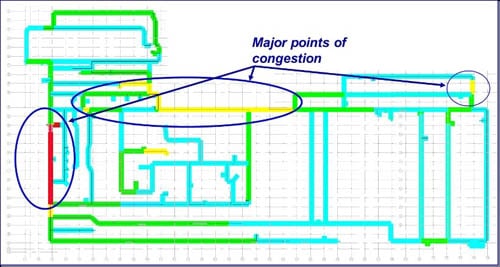 The manufacturing world has undergone many changes, so businesses must do everything possible to get the most out of their resources. Material waste, production bottlenecks, logistics issues, and equipment inefficiencies all impact production costs, customer satisfaction, and the overall quality of the final product.
The manufacturing world has undergone many changes, so businesses must do everything possible to get the most out of their resources. Material waste, production bottlenecks, logistics issues, and equipment inefficiencies all impact production costs, customer satisfaction, and the overall quality of the final product.
One way manufacturers can reduce waste, improve quality, and identify other areas of improvement is by implementing lean manufacturing techniques, including material flow analysis.
What Is Material Flow in Manufacturing?
Material flow in manufacturing refers to the movement of components, raw materials, and other inventory throughout the manufacturing process. Material flow is one of the most important factors for production companies because it helps businesses ensure they are meeting deadlines, avoiding costly mistakes, streamlining their workflow, and staying within budget.
With material flow systems, manufacturers can analyze their processes to understand how materials move between the various steps of the supply and value chains.
Types of Material Flow
The two primary types of material flow are external material flow and in-house material flow.
External material flow refers to logistics (the transportation of raw materials and finished goods), while in-house manufacturing material flow refers to any movement within the facility.
For example, the delivery of raw materials, the transfer to machining and assembly, and the loading of the finished products onto delivery trucks are examples of a basic in-house material flow.
Basic Principles of Material Flow

There are two main principles of material flow analysis: a systems approach and process/mass balance. The system approach refers to a system definition or model definition. A material flow system includes specific processes and a system boundary, allowing for control over the study’s parameters and a more focused analysis. The system approach also includes precise definitions of goods, substances, and materials.
Mass or process balance is about quantifying individual elements of processes, not just economic accounting. Taking such a specific approach is vital to implementing an industrial engineering solution, maintaining optimal operations, and reducing waste.
Examples of Material Flow in Manufacturing
There are several examples of material flow that play a role in manufacturing. These include:
- The flow of raw materials throughout the workplace.
- How various processing methods flow together.
- How finished goods flow from the business to the client.
- How various operators work in sync with each other to ensure material flow is smooth.
- The ability of machines to work together to create a finished product.
- How information flows between machines and people to optimize the process.
- How the individual engineering processes streamline the daily operations of the manufacturing company.
The Stages of Designing a Material Flow System
Creating an optimized material flow system to facilitate efficiency in the manufacturing workplace is a huge task, but it can be accomplished by following these four stages:
- Collect Data: In many organizations, the departments operate separately, creating siloed data and potential errors due to a lack of communication. Fix this by allowing access to data from the beginning to end of the production process and collecting data in a central location.
- Automate Process Monitoring: Automated programs that detect process deviations to ensure the material flow is uninterrupted.
- Visualize Current Data: The use of technology gives operators and managers relevant and timely views of the material flow, allowing them to complete their jobs efficiently.
- Predict & Act: Machine learning and predictive analytics enable technology to identify glitches and anticipate issues like bottlenecks or overflows, allowing employees to act quickly and prevent stoppage.
Benefits of Material Flow Analysis
Using material flow analysis in manufacturing can provide a wide variety of benefits, including:
- Streamlined Processes: Material flow analysis can remove redundancies, shorten turnaround times, and reduce operating costs.
- Increased User Satisfaction: By eliminating unnecessary steps and automating tasks that are still done by hand, it is possible to fill orders faster and more accurately, leading to more satisfied customers. And satisfied customers are more likely to become repeat customers, resulting in greater long-term revenue.
- Reduced Costs: When manufacturing businesses conduct a material flow analysis, they can save on capital investments and significantly reduce costs for storing, transporting, and handling materials.
- Less Waste: In lean manufacturing, waste is anything that doesn’t add value to the process. A material flow analysis can help manufacturers identify waste throughout the production process and understand how to allocate work hours and resources efficiently.
- Increase Operatore Efficiencies: By optimizing a component’s movement through the manufacturing process, the requirements for staffing and equipment can be significantly reduced.
- Reduce Travel & Congestion: Manufacturers can use material flow analysis to eliminate congestion and minimize travel time by rerouting materials.
Design Your Material Flow System Today
Designing a material flow system is challenging, which is why it’s critical that you work with a consultant like DSI. For over three decades, we’ve provided lean manufacturing and industrial engineering consulting services to businesses in many markets. We know that an effective material flow analysis can significantly impact the efficiency of overall operations, minimize waste, and increase your bottom line.
If you’re interested in learning more about material flow analysis or need help designing your system, please contact us today to schedule a consultation.